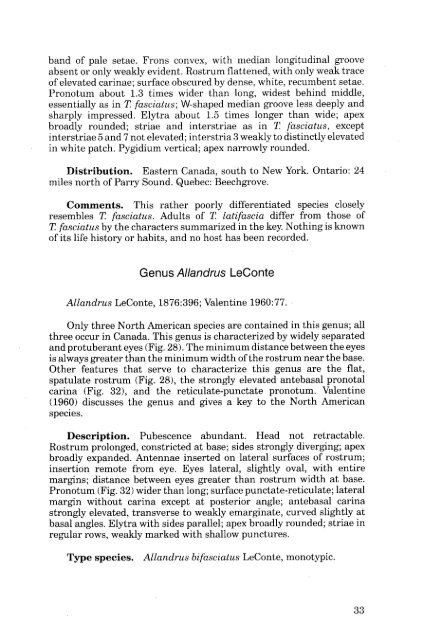Weevils - Entomological Society of Canada
Weevils - Entomological Society of Canada
Weevils - Entomological Society of Canada
You also want an ePaper? Increase the reach of your titles
YUMPU automatically turns print PDFs into web optimized ePapers that Google loves.
and <strong>of</strong> pale setae. Frons convex, with median longitudinal groove<br />
absent or only weakly evident. Rostrum flattened, with only weak trace<br />
<strong>of</strong> elevated carinae; surface obscured by dense, white, recumbent setae.<br />
Pronotum about 1.3 times wider than long, widest behind middle,<br />
essentially as in Z fasciatus; W-shaped median groove less deeply and<br />
sharply impressed. Elytra about 1.5 times longer than wide; apex<br />
broadly rounded; striae and interstriae as in I fasciatus, except<br />
interstriae 5 and 7 not elevated; interstria 3 weakly to distinctly elevated<br />
in white patch. Pygidium vertical; apex narrowly rounded.<br />
Distribution. Eastern <strong>Canada</strong>, south to New York. Ontario:24<br />
miles north <strong>of</strong> Parry Sound. Quebec: Beechgrove.<br />
Comments. This rather poorly differentiated species closely<br />
resembles T. fasciatus. Adults <strong>of</strong> T. latifascia differ from those <strong>of</strong><br />
T. fasciatus by the characters summarized in the key. Nothing is known<br />
<strong>of</strong>its life history or habits, and no host has been recorded.<br />
Genus Allandrus LeConte<br />
Allandrus LeConte, 1876: 396; Valentine 196O:7 7 .<br />
Only three North American species are contained in this genus; all<br />
three occur in <strong>Canada</strong>. This genus is characterized by widely separated<br />
and protuberant eyes (Fig. 28). The minimum distance between the eyes<br />
is always greater than the minimum width <strong>of</strong> the rostrum near the base.<br />
Other features that serve to characterize this genus are the flat,<br />
spatulate rostrum (Fig. 28), the strongly elevated antebasal pronotal<br />
carina (Fig. 32), and the reticulate-punctate pronotum. Valentine<br />
(1960) discusses the genus and gives a key to the North American<br />
species.<br />
Description. Pubescence abundant. Head not retractable.<br />
Rostrum prolonged, constricted at base; sides strongly diverging; apex<br />
broadly expanded. Antennae inserted on lateral surfaces <strong>of</strong> rostrum;<br />
insertion remote from eye. Eyes lateral, slightly oval, with entire<br />
margins; distance between eyes greater than rostrum width at base.<br />
Pronotum (Fig. 32) wider than long; surface punctate-reticulate; lateral<br />
margin without carina except at posterior angle; antebasal carina<br />
strongly elevated, transverse to weakly emarginate, curved slightly at<br />
basal angles. Elytra with sides parallel; apex broadly rounded; striae in<br />
regular rows, weakly marked with shallow punctures.<br />
T5pe species. Allandrus bifasciatus LeConte, monotypic.<br />
33

















